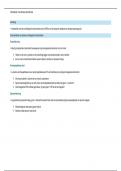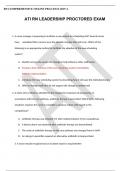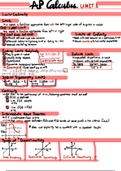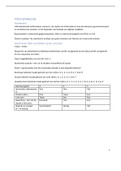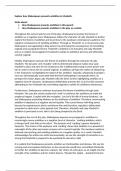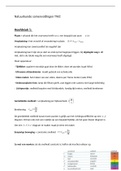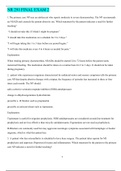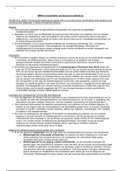Memory, attention and consciousness
Information-processing model of the mind
Sensory memory: Input from the senses → info stays for a second → analyzed
● Attention → input to short-term memory
● No attention → input quickly lost.
There is a separate store for each sensory system.
● Iconic memory: The visual sensory memory → info stays for about 250 milliseconds.
● Echoic memory: The auditory sensory memory → info stays for about 4 seconds.
Short-term store: Here all conscious info processing takes place
● Encoding: process movement from short-term store → long-term store.
● Retrieval: process movement from long-term store → short-term store →
remembering or recalling
Long-term memory: The long-term memory is passive → only available when it is
activated by the short-term memory.
● Effortful processes: require use of mental resources for their successful completion.
● Automatic processes: require little or none of the short-term store’s limited capacity.
● Dual-processing theories: When solving problems we use the effortful (slow) and
automatic (fast) processes.
Attention
Preattentive processing: If you pay attention to something → analyzed unconsciously →
included in your memory.
Selective listening: Due to difference in pitch and location we can select what we listen to.
● Cocktail-party phenomenon: At parties you can select what voices you listen to.
Selective viewing: When we focus on something we unconsciously ignore something else.
Priming: The activation of info that is already stored in long-term memory, by sensory input
→ info becomes more available to the person.
1. Preattentive processing: Stimuli where your attention is not focused activates
nonetheless sensory and perceptual areas in the brain → preattentive and conscious
processing relate to the same areas.
2. Attentive processing: Attention increases the activity that produces stimuli in
sensory and perceptual areas in the brain.
3. Shifts in attention: Neural mechanisms and forward parts of the cortex are
responsible for changing attention.
Spatial neglect: Brain damage → unable to see objects in the contralateral visual field →
side opposed to the damage.
Executive functions
Information-processing mechanisms. Consist of:
1. Updating working memory
, 2. Switching between tasks and mindsets
3. Inhibiting unwanted info or responses
General statements about executive functions
1. Unity and diversity → lot of people that are good at one of them, are good at all of
them → but every has its own unique abilities.
2. Genes influence the functions.
3. These functions are related to and predictive of clinical and societal outcomes.
4. There is a substantial developmental stability of the functions abilities.
Memory as the representation of knowledge
Explicit memory: Conscious memories → you’re aware of remembering something.
● Episodic memory: Memory of one’s own past experiences in a given moment →
hippocampus.
● Semantic memory: Memory not tied to a particular past experience → general
knowledge from our experiences → hippocampus.
Implicit memory: Unconsciously learned responses → your behavior shows that you
remember something, but you are unaware of it.
● Classical conditioning: The consequences.
● Procedural memory: Motor skills and habits.
● Priming: Our behavior is influenced by unconscious perception of certain things.
Memory as the process of remembering
Maintenance rehearsal: Holding info in short-term memory for a period of time.
Encoding rehearsal: Encoding info to the long-term memory.
Elaboration: Not to memorize but to understand → perhaps best way to encode info into
long-term memory. Certain concepts overlap at the neural level.
Chunking: You use knowledge that is already present to remember something → group
separate items into something that is seen as a whole.
Visualization: Images help to indicate relations between objects → easier to remember.
Anterograde amnesia: Damage to the brain → difficulty to create new memories.
Retrograde amnesia: Memories from just before an accident cannot be retrieved →
memories from a long time are easier to retrieve.
Consolidation: When memories go from an unstable to the stable form.
Retrieving info from long-term memory
Associations: Memories are stored in networks → items are linked → associated.
Retrieval cue: A stimulus or thought that primes a particular memory.
Association through contiguity: Associations are made because things often happen
together in the past.
Association through similarity: Association because they possess several same
characteristics.
Schema: Organisation of objects in space or events.
Script: Organisation of components in time.
Suggestions can cause false memories → leading questions → “What color sweater was
he wearing?” → but the person was wearing a shirt.
, Chapter 10
Intelligence and reasoning
Analogies and induction
● Analogy: Similarity in behavior, function or relationship between entities or situations
that are in other respects quite different → multiple areas of the prefrontal cortex →
integration of info.
Inductive reasoning: Attempt to infer some new principle or proposition from observations
that serve as clues.
● Availability bias: When we reason we tend to rely too strongly on info that is readily
available → ignore info that is less available.
● Confirmation bias: When we reason we tend try to confirm a hypothesis rather than
disconfirm it.
● Predictable-world bias: When we reason and try to see patterns in something
where there are no patterns.
Deduction and insight
Deductive reasoning: Attempt to derive logically the consequences that must be true if
certain premises are accepted as true. People often make the mistake with deductive
reasoning by paying more attention to the substantive info of a problem that the logic.
Insight problems: Problems designed to be unsolvable until one looks at them in a way that
is different from the usual way → entail mix of inductive and deductive reasoning.
● Functional fixedness: Failure to see an object as having a function other than its
visual one.
○ Design stance: Assuming tools are designed for an intended function.
Fast thinking → unconsciously and automatic.
Slow thinking → consciously and controlled.
Broaden-and-build-theory: Positive emotions broaden one’s scope of perception and
thought and increase creativity → Negative emotions narrow one’s focus of perception and
thought.
Cross-cultural differences in perception and reasoning
● Non-westerns tend to answer questions in practical and functional terms →
Westerns tend to answer questions in terms of abstract properties.
● East Asians tend to focus on and remember whole scenes and interrelationships →
Westerns tend to focus on and remember individual objects as separate entities.
The practice and theory of intelligence testing
Intelligence: reasoning, problem solving and acquiring new knowledge.
1. Binet-Simon Intelligence Scale: Oriented toward the skills required for schoolwork
2. Stanford-Binet Scale: First commonly used intelligence test in North America.
3. Wechsler Adult Intelligence Scale: Used today for adults.





